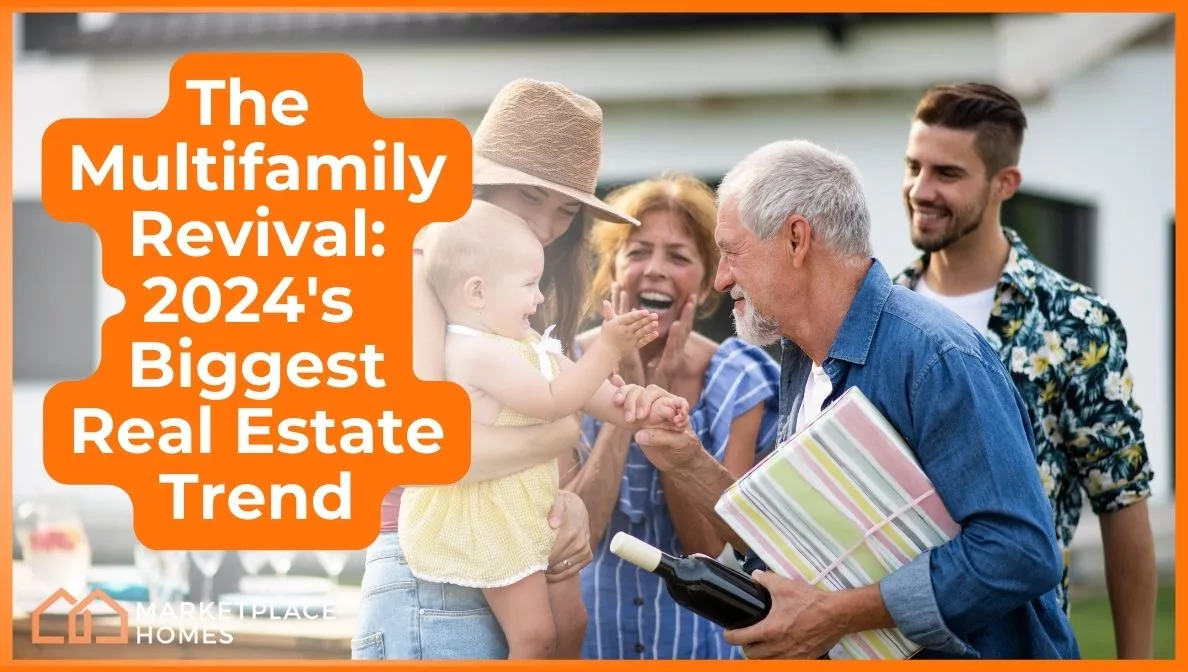The Multi-Family Revival
How are Americans reacting to still-high interest rates like last year, fierce competition with hopeful renters and single-family homebuyers, and an ongoing affordability crisis?
The answer lies in Multifamily Housing.
In a challenging housing market where nuclear households and singles are having a harder time achieving homeownership, going back to the “old ways” of living together in a multigenerational household is becoming more common. At a glance, here are some reasons:
-
Baby Boomer grandparents are more likely to be property owners, which means home equity and other financial assets to assist younger generations with co-signing for a single-family home.
-
Lower vacancy rates in rentals are motivating multifamily groups to find a larger single-family rental together. With multiple income streams, the group can more easily afford a home in spite of rent growth! They also win against home scarcity since they just need one home and not multiple homes.
-
Multifamily properties can be more affordable housing than nuclear family or singles housing since every working adult in the household can contribute to the rent or mortgage, allowing everyone an elevated lifestyle without being responsible for the entirety of the mortgage.
These are just a few of the benefits and why people are flocking to multifamily real estate. This is also motivating real estate investors to take a closer look at multifamily investments as prospective additions to their portfolios!
It’s all over the news!
The rising trend of multigenerational housing in the United States is all over the media, linking the surging multifamily market to financial difficulties. The COVID-19 pandemic certainly accelerated this trend, normalizing more families living together to save money, share caregiving responsibilities, and provide emotional support.
Not only are there financial benefits to living in multifamily units, but this allows extended family to purchase real estate at higher price points, such as new construction with more living space compared to an existing home that isn’t large enough to house multiple generations. It also makes it easier for families to explore larger, more expensive homes in the rental market.
Although there are many benefits, the media also examines the challenges associated with multigenerational housing. These include privacy concerns and a lack of boundaries. The higher the occupancy rate within a home, the more personalities are in the mix, which can make it important to have regular communication and clearly defined schedules and spaces for people who need privacy.
Why Multifamily housing?
According to a recent U.S. Census, 43.9 million homes, which comprise 31.4% of today’s housing, contains multiple generations. Multifamily housing is experiencing a surge in popularity in 2024, prompting ongoing multifamily construction.
1. An Aging Population
As empty nesters seek to downsize, one viable option is to either have their children move back in to share the bills and home upkeep or move in with their children or other relatives. This multigenerational setup offers a plethora of benefits including increased social connection and a cure for loneliness!
2. Not Leaving the Nest
Conversely, there is also an increase in young adults delaying homeownership due to elevated costs of living. The higher interest rates and home prices are making harder for young people to qualify for a loan with a lender, and likewise it’s more difficult to qualify for new units in a rental community.
3. Playing It Safe
Additionally, economic uncertainty and dynamic housing prices have made living together a more appealing option for many individuals and families to save money and wait for an easier real estate market.
4. Sharing Responsibilities
Furthermore, the convenience of living with grandparents, aunts, uncles, and older siblings means that families of young children can save a lot on childcare, which is prohibitively expensive in many submarkets. Cooking, cleaning, and other household tasks can be shared more easily compared to living alone.
5. Awesome Amenities
Multifamily communities often come with appealing amenities like fitness centers, communal spaces, and proximity to urban centers. This can make living together quite enjoyable, especially if residents have remote work capabilities.
For these reasons and more, multifamily housing is on the rise as developers respond to this growing demand with a new supply of residential properties.
Alicia Persson is a Content Strategist SEO writer at Marketplace Homes, utilizing previous years of experience on real estate teams that specialized in investments and property management. Before she joined Marketplace Homes, she was also a freelance writer for 7 years, leading to a specialization in real estate and home living content for boutique digital marketing agencies. During her writing years, she learned the basics of SEO and gained experience writing for many different clients, making her versatile at creating diverse content.
She is a proud University of Virginia master’s graduate and enjoyed her undergraduate years at the University of Mary Washington. When Alicia is not writing, she plays keytar and sings in a local 90’s rock cover band, or she spends time with her amazing family.

